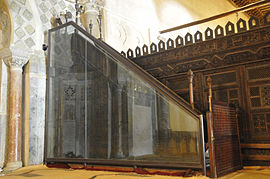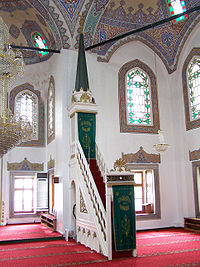- Minbar
-
 Picture showing the minbar of the Great Mosque of Kairouan (Mosque of Uqba); this pulpit, the oldest in existence, is still in its place of origin (in the prayer hall of the mosque) and it is protected by a glass panel in order to preserve this precious preaching chair, in Kairouan, Tunisia.
Picture showing the minbar of the Great Mosque of Kairouan (Mosque of Uqba); this pulpit, the oldest in existence, is still in its place of origin (in the prayer hall of the mosque) and it is protected by a glass panel in order to preserve this precious preaching chair, in Kairouan, Tunisia.
 Muslim scholar Ammar Nakshawani delivering a lecture from a mimbar in Dar es Salaam's Hussainia as part of the Ramadan ceremonies.
Muslim scholar Ammar Nakshawani delivering a lecture from a mimbar in Dar es Salaam's Hussainia as part of the Ramadan ceremonies.
A minbar (Arabic: منبر, also spelt mimbar or mimber) is a pulpit in the mosque where the imam (leader of prayer) stands to deliver sermons (khutbah خطبة ) or in the Hussainia where the speaker sits and lectures the congregation. The word is a derivative of the Arabic root n-b-r 'to raise, elevate'; the Arabic plural is manābir (Arabic: منابر).While minbars are usually more akin to pulpits in elevation and structures they have a function and position more similar to that of a lectern, emphasizing contact with the audience.[original research?] The minbar is usually shaped like a small tower with a pointed roof and stairs leading up to it. Some believe decorating it is part of the sunnah, oppositely the prophet Muhammed only had a platform with 3 steps. The minbar is located to the right of the mihrab, the niche that indicates the direction of prayer (i.e. towards Mecca). The minbar is also a symbol of authority.[1]
In some mosques there is a platform (müezzin mahfili in Turkish) opposite the minbar. That is the place where the assistant of the Imam, the muezzin, stands during prayer. The muezzin recites the answer to the prayer of the Imam. This feature is the Islamic equivalent of the pulpit found in Christian churches.[original research?]
Nowadays the oldest Islamic pulpit in the world to be preserved intact is the minbar of the Great Mosque of Kairouan (in the city of Kairouan in Tunisia).[2] Dating from the 9th century (at about 862 AD), it is an eleven-step staircase made of carved and sculptured teak wood. Composed of an assembly of over three hundred finely sculpted parts, the minbar of the Great Mosque of Kairouan is considered as a jewel of Islamic wooden art.[3]
References
- ^ Andrew Petersen, Dictionary of Islamic architecture, Routledge, 1996, page 191
- ^ Muḥammad ʻAdnān Bakhīt, History of humanity, UNESCO, 2000, page 345
- ^ Minbar of the Great Mosque of Kairouan (Qantara Mediterranean Heritage)
Bibliography
- Lynette Singer (ed.): The Minbar of Saladin. Reconstructing a Jewel of Islamic Art (London: Thames & Hudson 2008).
Categories:- Mosque architecture
- Islam stubs
Wikimedia Foundation. 2010.

